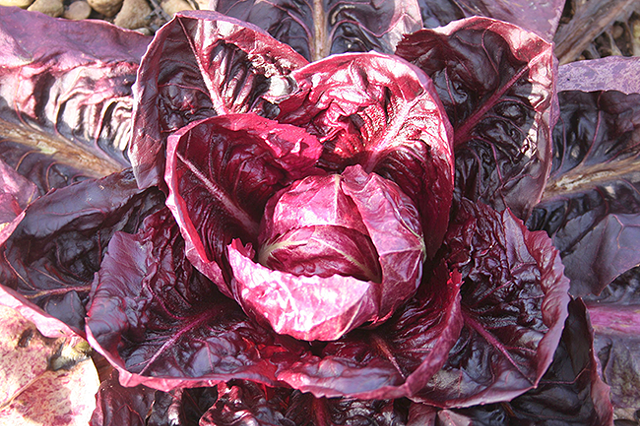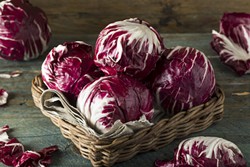It isn't true what they say about cooking radicchio. Whatever it is that they say, it isn't true.
Few plants radiate as much beauty as radicchio; even fewer do so while simultaneously delivering black belt-level bitterness.
In the produce section, radicchio stands out, its deep purple foliage making the veins appear all the more blindingly white, emanating a sense of clean crisp.
At home, you find that sharp dress to be more than skin deep. The leaves taste like something that most people would just as soon spit out as soon as possible. Because what they've learned about radicchio is wrong.
Those burgundy leaves are as tightly-packed as those of a head of cabbage, and just as crispy, but the radicchio's crisp depends on water pressure rather than the fiber that gives cabbage its crunch.
A more important distinction is that the spicy elements of cabbage flavor do mellow with cooking, unlike the bitter elements of radicchio.

Confusing radicchio and cabbage may be at the root of why everyone is wrong about radicchio; even Wikipedia seems to conflate the two, which come from different plant families entirely.
Every recipe for cooked radicchio that you will find includes some note about how braising or grilling or whatevering radicchio will soften, mellow, relax or otherwise temper its taste. That may work for cabbage, but radicchio is a whole different plant.
If anything softens when you cook radicchio, it's the radicchio itself, which collapses into a damp heap as the leaves weep the water that had once pressurized their stout bodies, which are no longer royal purple and dazzling white, but dilute gray brown.
All of the bitterness remains, and that's OK. The problem is the slimy, stringy remains of a dish that appears to be in a state of decay, and shouldn't have been prepared to begin with.
Because most toxins are bitter, humans have understandably become wired to regard bitter flavors with extreme skepticism. But clearly we are also born with the capacity to override this aversion, and actually come around to appreciate certain bitter flavors on a case-by-case basis.
Chocolate, coffee and beer, for example, have all earned passes, as they are non-toxic, or even pleasantly intoxicating, or stimulating, and make us feel good in various ways.
But with bitter vegetables the benefit of swallowing is not so immediately obvious. And without something to compel us to accept a certain type of bitterness, we often stay in default mode, and simply avoid these flavors.
But these bitter flavors, aside from the various feelings they invoke, are worth exploring for the sake of flavor alone.
Jennifer McLagan, author of the award-winning Bitter: A Taste of the World's Most Dangerous Flavor, likens bitterness to a kind of wizened charisma, "... a silver-haired man in a tailored suit, with a hint of a bad-boy aura about him."
"Bitter," she writes, "is a cultured, intriguing, and sophisticated taste, with a dangerous side. Who could be more fun to cook or to dine with?"
My wife seems to agree. She would sooner dine with a bowl of radicchio than her husband.
We live on a radicchio sanctuary institute, where my wife is chief caretaker, lead researcher and executive salad dressing maker. She is so far past the bitter barrier that bitter tastes better to her than sweet.
Many of these bitter flavors come from vitamins, antioxidants and various phytonutrients, which are biologically active plant compounds associated with positive health effects.
My wife eats radicchio like some people eat chips and salsa. She either peels the leaves off a head, or slices it into wedges. Either way, she's dipping the radicchio unit into her special dressing, which consists of two parts XVOO, one part soy sauce, one part vinegar (the vinegar portion being equal parts cider and balsamic vinegars) and half a lime for each cup of dressing.

Her typical dinner consists of six to 10 radicchio heads, or a massive bowl of leaves from the sanctuary, where the harvest of entire heads is frowned upon.
Her dressing is designed to celebrate, rather than hide the bitterness. She says eating all that radicchio makes her body feel good, approximately as good as coffee, beer and chocolate combined (not literally combined) make normal people feel.
Being a relative grasshopper in radicchiology compared to her, I don't mind a little assistance in order to get to that special place.
So I've designed my own chocolate and beer-based salad dressing, with which to handle life's bitterest leaves.
Some may consider it cheating to incorporate chocolate and beer, but I call it science.
By surrounding the bitter flavors of radicchio with bitter flavors from elsewhere, the bitter jolt of a naked bite is couched in layered complexity, a context that has the effect of softening the bitter like cooking wishes it could.
In addition to the beer — a citrusy IPA, ideally — and the chocolate, which is added in the form of powdered hot cocoa mix, the dressing contains bitter notes from olive oil, garlic powder and cumin.
Meanwhile, the bitter flavors are countered by the sweetness of the hot chocolate mix, and acidity from the vinegar, lime juice and the beer.